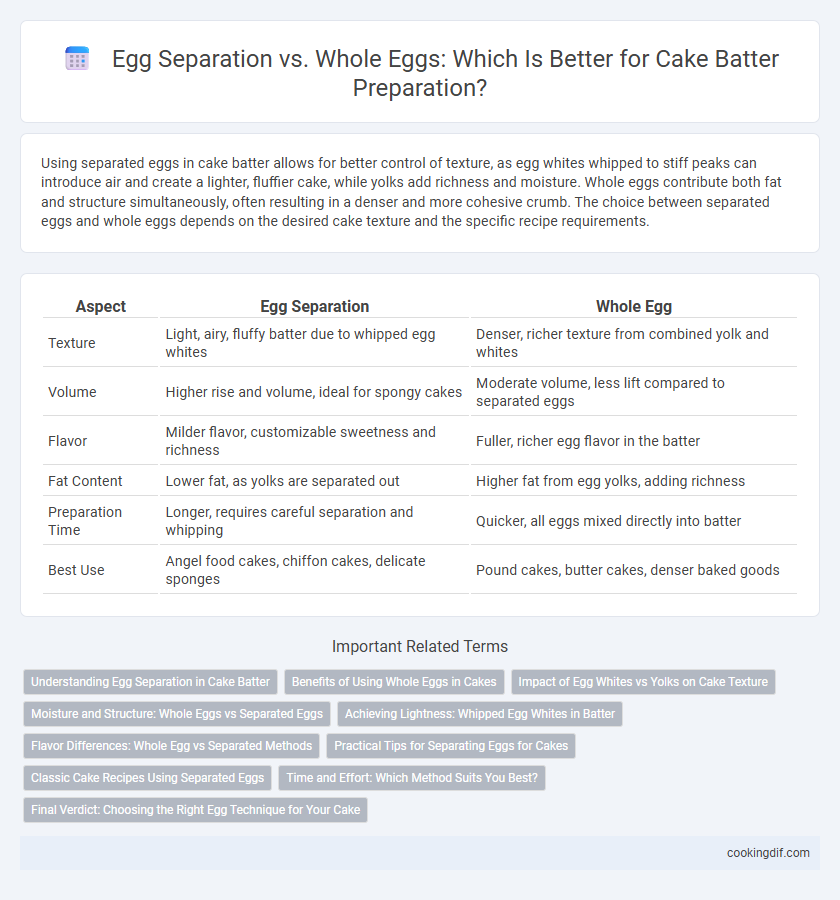Using separated eggs in cake batter allows for better control of texture, as egg whites whipped to stiff peaks can introduce air and create a lighter, fluffier cake, while yolks add richness and moisture. Whole eggs contribute both fat and structure simultaneously, often resulting in a denser and more cohesive crumb. The choice between separated eggs and whole eggs depends on the desired cake texture and the specific recipe requirements.
Table of Comparison
| Aspect | Egg Separation | Whole Egg |
|---|---|---|
| Texture | Light, airy, fluffy batter due to whipped egg whites | Denser, richer texture from combined yolk and whites |
| Volume | Higher rise and volume, ideal for spongy cakes | Moderate volume, less lift compared to separated eggs |
| Flavor | Milder flavor, customizable sweetness and richness | Fuller, richer egg flavor in the batter |
| Fat Content | Lower fat, as yolks are separated out | Higher fat from egg yolks, adding richness |
| Preparation Time | Longer, requires careful separation and whipping | Quicker, all eggs mixed directly into batter |
| Best Use | Angel food cakes, chiffon cakes, delicate sponges | Pound cakes, butter cakes, denser baked goods |
Understanding Egg Separation in Cake Batter
Separating eggs in cake batter preparation enhances texture by allowing precise control over moisture and fat content; egg whites contribute to volume and structure through protein aeration, while yolks provide richness and emulsification. Using whole eggs simplifies the process but may result in denser cakes due to the combined effects of fat and water in yolks and whites. Mastering egg separation improves crumb tenderness and rise, critical factors in achieving light, fluffy cakes with balanced flavor.
Benefits of Using Whole Eggs in Cakes
Using whole eggs in cake batter enhances moisture retention and provides better structure due to the combined protein and fat content. The yolks contribute richness and tenderness, while the whites improve aeration, resulting in a balanced texture and improved stability. Whole eggs also simplify the preparation process by eliminating the need for separate egg handling, reducing time and potential waste.
Impact of Egg Whites vs Yolks on Cake Texture
Egg whites contribute to a lighter, airier cake texture by incorporating more air during mixing, resulting in a tender crumb and increased volume. Yolks enhance richness, moisture, and a denser, more velvety crumb due to their fat content and emulsifying properties. Combining whole eggs balances these effects, producing a cake with moderate tenderness, structure, and moistness.
Moisture and Structure: Whole Eggs vs Separated Eggs
Using whole eggs in cake batter contributes balanced moisture and fat, promoting a tender crumb and cohesive structure. Separating eggs allows for distinct control: egg yolks enhance richness and moisture, while beaten egg whites introduce aeration and volume, resulting in a lighter texture. The choice between whole and separated eggs directly influences cake crumb density, moisture retention, and overall crumb structure.
Achieving Lightness: Whipped Egg Whites in Batter
Whipping egg whites separately from yolks introduces air into the batter, creating a lighter, fluffier cake texture compared to using whole eggs. The foam structure formed during egg white separation stabilizes the batter, enhancing volume and crumb softness. This technique is essential in recipes like sponge and chiffon cakes where maximum lightness is desired.
Flavor Differences: Whole Egg vs Separated Methods
Using whole eggs in cake batter enhances moisture and richness, contributing to a tender crumb and balanced flavor profile. Separating eggs allows for more control over texture; whipped egg whites introduce air for a lighter, fluffier cake with a subtle, cleaner taste. Flavor intensity is generally stronger in whole egg batters due to the yolk's fat content, while separated egg methods produce a more delicate flavor emphasizing cake lightness.
Practical Tips for Separating Eggs for Cakes
For optimal cake batter texture, separating eggs allows precise control over moisture and air incorporation; egg whites whipped separately add volume and lightness, while yolks contribute richness and color. Use cold eggs for easier separation, cracking each egg on a flat surface to prevent shell fragments and transferring yolk back and forth between shell halves to avoid breaking it. To maintain freshness, separate eggs over a bowl before adding to the batter, ensuring no yolk contaminates whites if a fluffy meringue is needed.
Classic Cake Recipes Using Separated Eggs
Classic cake recipes using separated eggs often yield a lighter and airier texture compared to those made with whole eggs. The egg whites, when whipped separately, incorporate more air into the batter, enhancing volume and tenderness. Yolks contribute richness and moisture, allowing precise control over the cake's structure and flavor profile.
Time and Effort: Which Method Suits You Best?
Separating eggs for batter preparation requires more time and effort, involving careful handling to avoid mixing yolks and whites, which is ideal for recipes demanding specific texture control like chiffon or angel food cakes. Using whole eggs simplifies the process significantly, saving time and minimizing cleanup, making it suitable for everyday cakes where ease and speed are priorities. Choosing between egg separation and whole eggs depends on the desired cake texture and the level of preparation time you can invest.
Final Verdict: Choosing the Right Egg Technique for Your Cake
Using separated eggs in cake batter enhances texture by incorporating more air, resulting in a lighter, fluffier crumb. Whole eggs contribute moisture and structure, offering a balanced, denser consistency ideal for richer cakes. Selecting the right egg technique depends on the desired cake outcome: opt for separated eggs for airy sponge cakes and whole eggs for moist, tender crumb varieties.
Egg separation vs Whole egg for batter preparation Infographic

 cookingdif.com
cookingdif.com